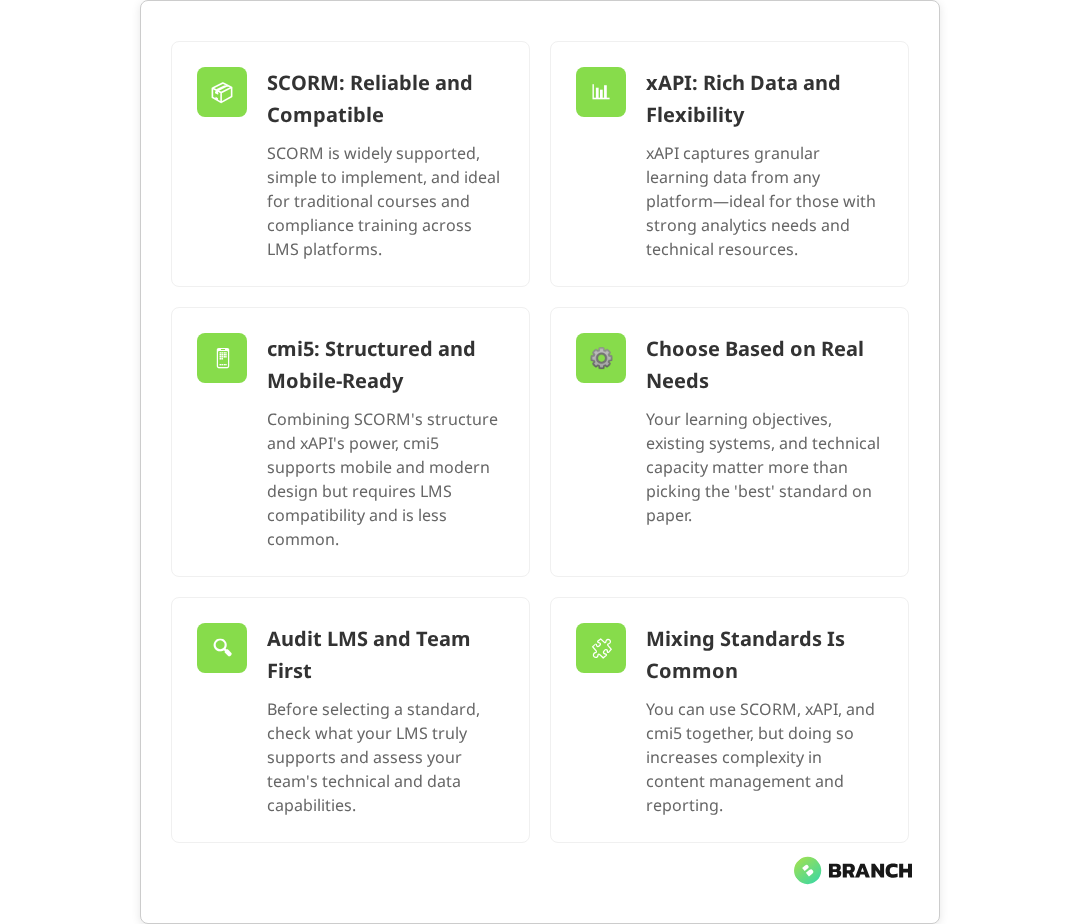If you’re planning an eLearning project, you’ve probably stumbled across acronyms like SCORM, xAPI, and cmi5 and maybe wondered if choosing the wrong one could doom your training program before it starts. The good news? It’s not as dramatic as all that. The even better news? Understanding these standards isn’t rocket science, and making the right choice comes down to knowing what you’re actually trying to accomplish.
This guide is for learning and development teams, CTOs, and product owners who need to make informed decisions about eLearning standards without getting lost in technical jargon. Whether you’re building a custom training platform, selecting an LMS, or trying to figure out if your current setup is holding you back, we’ll walk through the practical differences between these three standards and help you choose the one that makes sense for your situation.
Here’s what we’ll cover: how each standard actually works, what problems they solve (and which ones they don’t), and the real-world trade-offs you’ll face when implementing them. No buzzwords, no vendor pitches just clear guidance based on what we’ve learned building eLearning solutions for organizations that range from scrappy startups to enterprise training departments.
The Standards Landscape: What Each One Actually Does
Before diving into comparisons, let’s establish what these standards are designed to accomplish. At their core, SCORM, xAPI, and cmi5 are communication protocols they define how eLearning content talks to learning management systems (LMS) and what data gets tracked along the way.
Think of them like different languages your training content can speak. Just as you’d choose Spanish over Mandarin depending on your audience, you pick an eLearning standard based on what kind of learning experiences you’re creating and what data you need to collect.
SCORM: The Reliable Workhorse
SCORM (Sharable Content Object Reference Model) has been around since 2001, making it the granddaddy of eLearning standards. SCORM 1.2 was released in October 2001 and became one of the most widely adopted versions of the standard. It defines how content packages are structured, launched, and tracked within an LMS environment covering everything from packaging content into standardized ZIP files to enabling consistent tracking across platforms.
What SCORM does well:
- Universal compatibility virtually every LMS supports it, ensuring content works across platforms
- Proven reliability for traditional course structures with straightforward completion tracking
- Straightforward implementation and debugging
- Comprehensive packaging standards for content portability
What SCORM struggles with:
- Limited to browser-based learning within an LMS it requires an active browser session and can’t track offline or mobile app-based learning
- Basic tracking mostly completion, scores, and time spent, with limited detail on learner interactions
- Can’t track learning that happens outside the LMS environment
- Sequential, course-centric approach doesn’t fit modern learning patterns
xAPI: The Ambitious Data Collector
xAPI (Experience API), also known as Tin Can API, emerged around 2013 through a research project led by the Advanced Distributed Learning initiative. Unlike SCORM’s LMS-centric approach, xAPI was designed with bigger ambitions: capturing learning activities wherever they happen mobile apps, simulations, job performance, even offline experiences.
What xAPI does well:
- Tracks learning beyond traditional eLearning courses across diverse platforms and contexts
- Rich data collection through statement-based tracking that captures detailed learner interactions
- Works across platforms, devices, and environments, including offline scenarios
- Supports complex learning analytics and reporting with granular behavioral data
What xAPI struggles with:
- Implementation complexity requires significantly more technical expertise than SCORM
- Needs a Learning Record Store (LRS) to function properly, adding infrastructure complexity
- Data quality depends heavily on thoughtful implementation
- Limited value unless you actively use the rich data it collects
cmi5: The Best-of-Both-Worlds Attempt
cmi5, finalized in 2016, tries to combine SCORM’s simplicity with xAPI’s flexibility. It uses xAPI for data transport but adds more structure around course launching and tracking requirements.
What cmi5 does well:
- Leverages xAPI’s data richness with more standardization
- Better mobile and responsive design support than SCORM
- Cleaner separation between content and LMS
- More reliable than pure xAPI implementations
What cmi5 struggles with:
- Still relatively new with limited industry adoption
- Fewer vendor tools and resources available
- Requires LMS support that many systems lack
- Added complexity compared to SCORM without always delivering proportional benefits

What the research says
Industry evidence provides clear guidance on when each standard works best:
- SCORM’s widespread adoption is well-documented multiple studies confirm that virtually all major LMS platforms support SCORM, making it the most compatible choice for organizations needing broad platform support.
- xAPI’s technical complexity is consistently reported research shows implementations require significantly more technical expertise, API integration skills, and ongoing system maintenance compared to SCORM.
- Mobile learning limitations are clear for SCORM evidence confirms SCORM cannot track learning outside browser environments, making it unsuitable for offline or mobile app-based training.
- Early evidence on cmi5 shows promise but limited adoption while combining benefits of both standards, industry adoption remains modest due to limited LMS support and fewer available tools.
- Data utilization gaps are commonly reported organizations often choose xAPI for advanced analytics but fail to develop processes to analyze and act on the rich data it provides.
When to Choose Each Standard: A Practical Framework
The choice between SCORM, xAPI, and cmi5 isn’t about picking the “best” standard it’s about matching the right tool to your specific context and goals. Here’s a framework to help you decide:
| Standard | Best for | Skip if | Implementation Effort |
|---|---|---|---|
| SCORM | Traditional course delivery, regulatory compliance, broad LMS compatibility needs | You need mobile learning, complex analytics, or tracking outside the LMS | Low |
| xAPI | Learning analytics, multi-platform experiences, performance support tracking | You lack technical resources or won’t actively use rich data | High |
| cmi5 | Modern course structure with better mobile support and some analytics | Your LMS doesn’t support it or you need maximum compatibility | Medium |
SCORM Makes Sense When:
You’re building traditional eLearning courses that need to work across multiple LMS platforms. This is especially true for organizations that:
- Prioritize compatibility over innovation when you need content that works everywhere without vendor-specific modifications
- Focus on compliance training where simple completion tracking and basic scoring meet regulatory requirements
- Have limited technical resources SCORM’s maturity means abundant tools, documentation, and vendor support
- Work with external training vendors most off-the-shelf eLearning content comes in SCORM format
A healthcare organization rolling out mandatory safety training across multiple hospital systems would likely choose SCORM. They need reliable tracking, broad compatibility, and don’t require sophisticated analytics just proof that staff completed required modules.
xAPI Makes Sense When:
You’re serious about learning analytics and need to track diverse learning activities. Consider xAPI if you:
- Track learning beyond formal courses mobile apps, job aids, simulations, or real-world performance
- Have analytics capabilities and intent dedicated staff to analyze rich data and act on insights
- Support complex learning ecosystems multiple platforms, informal learning, social learning components
- Need granular reporting detailed learner journeys, competency mapping, or personalized learning paths
A software company building an internal developer training program might choose xAPI to track everything from code commits and peer reviews to formal course completions, creating a comprehensive picture of skill development.
Read more: Deep dive into technical implementation details for SCORM, xAPI, and cmi5 standards.cmi5 Makes Sense When:
You want some of xAPI’s benefits without full complexity, and your LMS supports it. Consider cmi5 if you:
- Need better mobile experiences than SCORM provides but don’t require full cross-platform tracking
- Want structured analytics more than SCORM offers, but with less implementation complexity than xAPI
- Have modern LMS infrastructure that supports cmi5 and you’re not constrained by legacy systems
- Plan to evolve toward richer analytics cmi5 can be a stepping stone to full xAPI implementation
A mid-sized consulting firm updating their learning infrastructure might choose cmi5 to modernize their training delivery while maintaining structured course formats their learning team understands.
Implementation Reality Check: What Actually Happens
Theory is one thing; implementation reality is another. Based on what we see in practice, here are the factors that often matter more than technical specifications:
The LMS Compatibility Question
Your LMS choice often constrains your standard options more than your ideal learning strategy does. Many organizations discover their “modern” LMS has spotty xAPI support or no cmi5 capability at all. Before falling in love with a standard, audit what your current (or planned) LMS actually supports not what the marketing materials claim.
Development Resource Requirements
SCORM development can often be handled by instructional designers with basic technical skills and readily available authoring tools. xAPI implementations typically require developers who understand JSON, REST APIs, and learning record store architecture. cmi5 falls somewhere in between but requires specialized knowledge that’s still scarce in the market.
Content Authoring Tool Limitations
Most off-the-shelf authoring tools Articulate, Captivate, Lectora export primarily to SCORM with limited xAPI support. If you’re planning to use these tools, xAPI or cmi5 might add development overhead that negates their benefits.
The Data Analysis Gap
This is the big one: many organizations that choose xAPI for its rich analytics never actually analyze the rich data. They get excited about granular learner statements and detailed interaction tracking, then discover they lack the staff, tools, or processes to turn that data into actionable insights. It’s like buying a race car when you mostly drive to the grocery store.
Making the Decision: A Step-by-Step Process
Rather than starting with technical features, begin with your actual requirements and constraints. Here’s a practical decision process:
Step 1: Define Your Tracking Requirements
Be honest about what you actually need to measure:
- Compliance tracking: Did employees complete required modules? (SCORM handles this fine)
- Basic progress monitoring: How far did learners get, what scores did they achieve? (SCORM or cmi5)
- Learning analytics: What specific interactions, behaviors, or learning paths lead to better outcomes? (xAPI)
- Cross-platform tracking: Learning that happens in mobile apps, on the job, or across multiple systems? (xAPI)
Step 2: Assess Your Technical Capabilities
Evaluate your team’s current skills and bandwidth:
- Do you have developers comfortable with APIs and data integration?
- What authoring tools does your team currently use?
- How much time can you realistically dedicate to implementation and maintenance?
- Do you have data analysis capabilities to make use of rich tracking data?
Step 3: Review Your Infrastructure
Check what your current systems actually support:
- LMS capabilities and roadmap
- Learning record store availability (for xAPI)
- Integration requirements with other systems
- Mobile and responsive design requirements
Step 4: Consider Your Timeline and Budget
Different standards have different implementation costs:
- SCORM: Lower upfront costs, abundant vendor options, faster implementation
- xAPI: Higher development costs, need for LRS, ongoing data management overhead
- cmi5: Medium complexity, fewer vendor options, potential future-proofing benefits
When to Build Custom vs. Extend Existing Tools
Sometimes the standard you choose matters less than whether you build custom solutions or work within existing platform constraints. Here’s when each approach makes sense:
Extend Existing Tools When:
- Your current LMS meets most needs with minor gaps
- You have limited development resources
- Compliance and basic tracking satisfy your requirements
- Your learning team is comfortable with existing workflows
Build Custom When:
- Your learning requirements don’t fit standard LMS patterns
- You need tight integration with performance support tools
- Advanced analytics are central to your learning strategy
- You have development resources and long-term maintenance capability
Partner with Specialists When:
You know what you want to achieve but lack the internal expertise to implement it effectively. A team like Branch Boston can help you navigate the technical complexity while keeping focus on your actual learning objectives whether that means building custom eLearning platforms that support multiple standards or implementing LMS solutions that align with your chosen approach.
The key is finding partners who understand both the technical capabilities of different standards and the practical realities of learning and development teams. You want implementers who ask about your learning objectives before they start talking about APIs.
Looking Forward: Trends and Practical Recommendations
The eLearning standards landscape continues evolving, but slowly. SCORM isn’t disappearing anytime soon too much content and too many systems depend on it. xAPI adoption is growing but remains concentrated in organizations with specific analytics needs and technical capabilities. cmi5 is gaining traction as a middle path, but adoption varies significantly by industry and use case.
Our practical recommendations:
- Default to SCORM unless you have specific requirements it can’t meet. It’s boring, but it works.
- Choose xAPI when you have clear analytics goals, technical resources, and commitment to acting on rich data.
- Consider cmi5 when your LMS supports it and you want some modernization without full xAPI complexity.
- Plan for evolution build your eLearning infrastructure in ways that allow you to add capabilities over time rather than requiring complete rebuilds.
Most importantly, remember that the standard is just the plumbing. Great learning experiences depend more on instructional design, user experience, and organizational commitment than on which technical standard you choose. Pick the one that fits your current reality and capabilities, then focus on creating training that actually helps people do their jobs better.
If you’re looking to understand the broader eLearning development process or need help integrating training data with performance management systems, those decisions will likely have more impact on your program’s success than standard selection. But getting the standard choice right ensures your technical foundation supports rather than constrains your learning objectives.
Want to explore how these standards might work in your specific context? Our eLearning services team helps organizations navigate these decisions based on real requirements rather than theoretical capabilities. We’ve implemented all three standards across different industries and can help you cut through the complexity to find what actually works for your situation.
FAQ
Can I use multiple eLearning standards within the same LMS?
Yes, most modern LMS platforms support multiple standards simultaneously. You might use SCORM for legacy content, xAPI for new analytics-driven modules, and cmi5 for mobile-optimized courses. However, this creates complexity in content management and reporting that should be weighed against the benefits of standard-specific features.
Is xAPI worth the implementation complexity if I just want better mobile support?
Probably not. If mobile compatibility is your primary concern, cmi5 offers better mobile support than SCORM with less implementation overhead than full xAPI. Alternatively, responsive SCORM content or mobile-optimized authoring tools might meet your needs without changing standards at all. Reserve xAPI for situations where you genuinely need its cross-platform tracking and rich analytics capabilities.
What happens to my existing SCORM content if I switch to xAPI or cmi5?
Your existing SCORM content will continue working in any LMS that supports SCORM which is virtually all of them. You don't need to convert everything at once. Many organizations run mixed environments, using SCORM for stable content while building new experiences in xAPI or cmi5. Conversion is possible but often not worth the effort unless content needs significant updates anyway.
Do I need a Learning Record Store (LRS) to use xAPI, and what does that involve?
Yes, xAPI requires an LRS to store and retrieve learning statements. This can be standalone software, a cloud service, or functionality built into your LMS. The LRS becomes another system to maintain, backup, and secure. You'll also need processes for data management, privacy compliance, and integration with other systems that need access to learning data.
How do I know if my current LMS actually supports the standard I want to use?
Test with real content, don't rely on marketing claims. Many LMS vendors claim xAPI or cmi5 support but have limited implementations that don't work with all content types or authoring tools. Request a technical demo with sample content similar to what you plan to build, and ask specific questions about features like mobile support, offline capabilities, and data export options.




